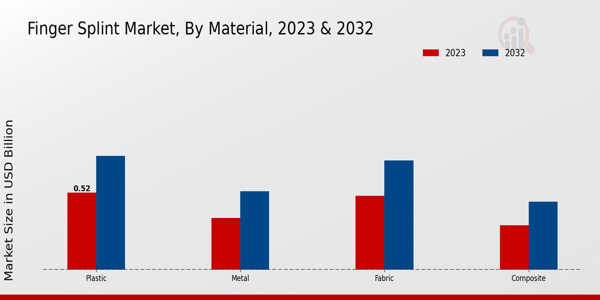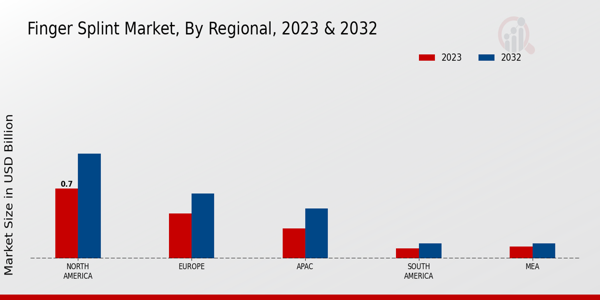Finger Splint Market Overview
As per MRFR analysis, the Finger Splint Market Size was estimated at 1.83 (USD Billion) in 2024. The Finger Splint Market Industry is expected to grow from 1.91 (USD Billion) in 2025 to 2.86 (USD Billion) till 2034, at a CAGR (growth rate) is expected to be around 4.56% during the forecast period (2025 - 2034).
Key Finger Splint Market Trends Highlighted
The Global Finger Splint Market is influenced by several key market drivers. Growing awareness about the benefits of finger splints in treating injuries and conditions such as fractures, sprains, and arthritis is leading to increased demand. Advancements in material technology, such as lightweight and breathable fabric, enhance patient comfort and compliance, further fueling market growth. The rise in sports activities and physical labor also contributes to a higher incidence of finger-related injuries, pushing the need for effective treatment solutions. Moreover, there is a notable increase in the aging population, which often requires more medical attention for finger dysfunctions, thus expanding the market.Various opportunities exist within the Global Finger Splint Market that can be explored. There is potential for innovation in product design to cater to specific needs, such as customizable splints or those with enhanced therapeutic properties. Additionally, advancements in telehealth may allow for better patient monitoring and follow-ups, driving the growth of finger splint usage. Market players can also consider expanding their reach in developing regions where awareness about finger injuries and treatment options is still growing. Collaborations with medical professionals for educational initiatives could further enhance brand visibility and preference.Recent times have shown a trend toward increased online sales channels for finger splints, making them easily accessible to a wider audience. The integration of e-commerce platforms presents an opportunity for manufacturers to reach customers directly, bypassing traditional retail limitations. Personalized solutions and user-friendly designs are gaining traction as consumers seek products that cater to their specific recovery needs. This trend aligns with broader consumer demand for convenience and tailored health solutions, shaping the landscape of the finger splint market.

Source: Primary Research, Secondary Research, MRFR Database and Analyst Review
Finger Splint Market Drivers
Rising Incidence of Hand Injuries and Conditions
The Global Finger Splint Market Industry is significantly driven by the increasing prevalence of hand-related injuries and conditions. With a growing aging population and a rise in activities that lead to occupational and recreational injuries, the demand for finger splints is on the rise. Hand fractures, sprains, and post-surgical recovery situations are common occurrences that necessitate the use of finger splints. Additionally, conditions such as arthritis, which also affects finger mobility and strength, are becoming more prevalent in the population.These injuries and conditions often require immobilization to ensure proper healing or rehabilitation, leading individuals to seek effective solutions like finger splints. Furthermore, the trend towards more active lifestyles, both recreationally and occupationally, has resulted in a greater incidence of injuries. This further boosts the demand for finger splints, as individuals look for ways to maintain their mobility and return to their activities as quickly as possible.The growing recognition of the importance of first aid and immediate care in such injuries is also contributing to the market's expansion. Consequently, the Global Finger Splint Market Industry is benefitting from this increased demand for effective and innovative splinting solutions to address hand injuries.
Technological Advancements in Product Development
Technological advancements in the design and materials used in finger splints are fostering innovation within the Global Finger Splint Market Industry. Manufacturers are increasingly incorporating advanced materials such as lightweight and breathable polymers that improve comfort and support. The introduction of customizable splints that can be molded to fit individual patients enhances user experience and recovery outcomes. Additionally, developments in splint design that allow for easy application and removal while providing adjustable levels of support and immobilization are becoming more common.This focus on user-friendly designs caters to a diverse demographic, including athletes and those with chronic conditions, enhancing market growth prospects.
Growing Awareness and Accessibility of Healthcare
Increased awareness regarding health and wellness, coupled with an expanding healthcare infrastructure, is boosting the Global Finger Splint Market Industry. As more people seek treatment for hand injuries, healthcare providers are emphasizing the availability and effectiveness of finger splints as a crucial part of recovery protocols. This growing recognition is leading to improved access to medical supplies and devices, including finger splints, in hospitals, clinics, and pharmacies.As professionals advocate for preventive care and early intervention, the market is likely to see continued growth driven by patient education and healthcare accessibility.
Finger Splint Market Segment Insights:
Finger Splint Market Material Insights
The Global Finger Splint Market revenue in 2023 is valued at around 1.67 USD Billion and is expected to see significant growth, reaching approximately 2.5 USD Billion by 2032, driven by increasing demand for effective finger immobilization solutions. A pivotal segment within this market is the Material classification, which includes Plastic, Metal, Fabric, and Composite. Among these materials, Plastic emerges as a leading component, valued at 0.52 USD Billion in 2023 and projected to reach 0.77 USD Billion in 2032. The significance of Plastic lies in its lightweight nature, flexibility, and ease of use, catering to a broad audience seeking both comfort and functionality.The Metal segment is valued at 0.35 USD Billion in 2023, expected to rise to 0.53 USD Billion by 2032. Metal splints are preferred for their durability and strength, providing a reliable option for patients requiring more rigid support during recovery. Fabric represents another important material in the finger splint landscape, with a valuation of 0.5 USD Billion in 2023, anticipated to grow to 0.74 USD Billion by 2032. The soft texture of Fabric makes it an excellent choice for extended use and is appealing to consumers who prioritize comfort alongside support.Lastly, the Composite segment, valued at 0.3 USD Billion in 2023, is expected to increase to 0.46 USD Billion in 2032. Composites, combining benefits from different materials, can provide a balance of flexibility and support, meeting the diverse needs of various consumers. As the Global Finger Splint Market segmentation illustrates, the Material components not only highlight the variety of offerings available but also reflect the ongoing trends and consumer preferences towards materials that enhance comfort and healing efficacy. The growth in this market segment can also be attributed to increased awareness of hand injuries and the vital role of finger splints in rehabilitation, as well as advancements in material technology leading to better product designs.Thus, the Global Finger Splint Market statistics exemplify a dynamic landscape where the choice of materials plays a crucial role in shaping market offerings and responding to evolving consumer demands.

Source: Primary Research, Secondary Research, MRFR Database and Analyst Review
Finger Splint Market Type Insights
The Global Finger Splint Market is witnessing steady growth, with an overall market valuation of 1.67 USD Billion in 2023. The market segmentation by Type reveals several important categories, including Static Splints, Dynamic Splints, and Buddy Splints. Static Splints are particularly important due to their ability to immobilize finger injuries, allowing for optimal healing and recovery. Dynamic Splints, on the other hand, are gaining traction as they provide a more flexible approach to rehabilitation, allowing movement while still applying necessary support, thereby enhancing patient satisfaction and compliance.Buddy Splints, designed primarily for injuries affecting adjacent fingers, hold significant importance in both pediatric and adult care settings. The overall trends in the Global Finger Splint Market data show a growing awareness of the benefits of appropriate splinting techniques, driven by an increase in sports injuries and the aging population. However, challenges such as the availability of alternatives and varying patient preferences can impact market growth. Despite these challenges, the segment presents numerous opportunities for innovation and the introduction of advanced splinting solutions within the Global Finger Splint Market industry.Overall, market growth remains promising, with a projected increase driven by the evolving dynamics of finger splint treatments and rehabilitation needs.
Finger Splint Market Application Insights
The Global Finger Splint Market is poised for substantial growth, projected to reach a valuation of 1.67 billion USD in 2023. This market is divided into significant applications, including fractures, tendon injuries, and post-surgery rehabilitation. The fractures application holds substantial importance, as it addresses a large volume of injuries arising from various activities, driving demand for effective orthotic solutions. Tendon injuries are also a critical application area, reflecting the need for specialized support during recovery, which contributes to overall health and restoration of function.Additionally, the post-surgery segment demonstrates significant relevance as it assists in stabilization and healing following surgical interventions, highlighting its role in the recovery process. These applications together play a crucial role in the overall market dynamics, shaped by an increase in sporting activities, work-related injuries, and an aging population requiring medical support. Factors such as rising awareness about finger injury management and advances in medical technology further enhance the Global Finger Splint Market data, providing the industry with robust growth opportunities.Overall, the Global Finger Splint Market Statistics indicate a positive trend, given the evolving landscape of healthcare and rehabilitation.
Finger Splint Market End Use Insights
The Global Finger Splint Market revenue in 2023 is estimated at 1.67 Billion USD, with significant growth projected in the coming years. The market segmentation includes key end-use categories such as hospitals, homecare, and rehabilitation centers, each playing a crucial role in the overall dynamics of the market. Hospitals are pivotal as they provide immediate treatment for finger injuries, leading to a substantial demand for finger splints. Homecare is increasingly significant due to the growing trend of at-home recovery and management of minor injuries, reflecting a shift in patient preference towards personalized care.Rehabilitation centers dominate as they support recovery through specialized therapy, creating a steady need for finger splints among patients undergoing rehabilitation processes. Together, these segments present opportunities driven by an aging population, increasing awareness of finger injuries, and innovations in splint technology. However, challenges such as budget constraints in healthcare facilities and the availability of alternatives may influence the market's future growth trajectory. Overall, the Global Finger Splint Market statistics highlight the importance of these end-use segments in shaping market growth from 2024 to 2032.
Finger Splint Market Regional Insights
The Global Finger Splint Market showcases a diverse regional segmentation, reflecting the varying demand and growth potential across different areas. In North America, the market is expected to hold a significant portion, valued at 0.7 USD Billion in 2023 and projected to reach 1.05 USD Billion by 2032, indicating its majority holding in the market. Europe follows with a value of 0.45 USD Billion in 2023, set to grow to 0.65 USD Billion by 2032, demonstrating significant growth opportunities driven by increasing healthcare expenditure. The Asia-Pacific (APAC) region, valued at 0.3 USD Billion in 2023 and anticipated to grow to 0.5 USD Billion by 2032, represents a growing market due to rising awareness and a booming population.South America, although smaller, shows steady growth from 0.1 USD Billion in 2023 to 0.15 USD Billion in 2032, reflecting increasing access to medical resources. Lastly, the Middle East and Africa (MEA) region, valued at 0.12 USD Billion in 2023 and reaching 0.15 USD Billion by 2032, highlights emerging markets that are beginning to develop a foothold in the Global Finger Splint Market. Together, these regions present a dynamic landscape of growth drivers and opportunities interacting with local healthcare needs and economic conditions.

Source: Primary Research, Secondary Research, MRFR Database and Analyst Review
Finger Splint Market Key Players and Competitive Insights:
The Global Finger Splint Market is characterized by a dynamic and evolving landscape, driven by the increasing prevalence of finger injuries and conditions requiring immobilization and support. A variety of key players operate within this market, providing a range of products designed to cater to different needs, including immobilization, rehabilitation, and support. The competitive insights reveal a focus on innovation, enhanced product offerings, and strategic alliances that enable companies to capture significant market share. In addition to the variety of splints that are commercially available, companies are leveraging technology and consumer feedback to improve the efficacy and comfort of their products, thereby establishing themselves as leaders in this niche market.Futuro stands out in the Global Finger Splint Market with its strong reputation for quality and reliability. The company is renowned for producing high-quality finger splints that provide effective immobilization while maintaining user comfort. Futuro's product line includes options that are tailored for various conditions and levels of injury, appealing to both medical professionals and consumers. The brand’s emphasis on user-friendly design and adjustable fits enhances its market presence, helping it to penetrate diverse demographics. Additionally, Futuro adopts a multi-channel distribution strategy, which includes both direct and indirect sales channels, facilitating a broad reach to customers seeking finger splint solutions.Alimed has established a significant foothold in the Global Finger Splint Market through its comprehensive portfolio of medical products, notably in the orthopedics and rehabilitation sectors. The company offers a variety of finger splint options that cater to specific medical needs, emphasizing the importance of comfort and functionality. Alimed is recognized for its commitment to product development, often integrating feedback from healthcare professionals and end-users into its design process. Their strategic partnerships with healthcare providers contribute to enhancing brand loyalty and visibility in the market. Alimed's focus on quality assurance and customer satisfaction plays a crucial role in maintaining its competitive advantage as it continues to innovate within the sector and respond to emerging trends in healthcare.
Key Companies in the Finger Splint Market Include:
- Futuro
- Alimed
- 3M
- DJO Global
- Medline Industries
- Surgical Appliance Industries
- Orthomerica Products
- Bauerfeind
- Ottobock
- DeRoyal Industries
- TheraGun
- Kinetec
- Smith and Nephew
- Breg
- Performance Health
Finger Splint Market Industry Developments
The Global Finger Splint Market has recently seen notable developments, with several companies enhancing their product lines and market presence. Companies like Futuro and Alimed are focusing on innovative improvements in their splint designs to cater to diverse customer needs. 3M continues to leverage its strong brand recognition to expand its market reach, while DJO Global and Medline Industries are actively increasing their distribution channels, driving growth in demand for finger splints. Surgical Appliance Industries and Orthomerica Products reported enhancements in product materials that improve comfort and effectiveness for users. Meanwhile, Bauerfeind and Ottobock are investing in research and development for advanced orthopedic solutions, contributing to competitive dynamics in the market. DeRoyal Industries has also taken steps to strengthen its foothold through strategic partnerships and expanded product offerings. On the financial front, the market valuation of these companies is expected to rise, propelled by increased health awareness and an aging population, leading to a greater need for supportive devices. The collaborative ventures among these players could further amplify their market impact, fostering innovation and ultimately enhancing customer experience.
Finger Splint Market Segmentation Insights
Finger Splint Market Material Outlook
- Plastic
- Metal
- Fabric
- Composite
Finger Splint Market Type Outlook
- Static Splints
- Dynamic Splints
- Buddy Splints
Finger Splint Market Application Outlook
- Fractures
- Tendon Injuries
- Post-Surgery
Finger Splint Market End Use Outlook
- Hospitals
- Homecare
- Rehabilitation Centers
Finger Splint Market Regional Outlook
- North America
- Europe
- South America
- Asia Pacific
- Middle East and Africa
| Report Attribute/Metric |
Details |
|
Market Size 2024
|
1.83 (USD Billion)
|
|
Market Size 2025
|
1.91 (USD Billion)
|
|
Market Size 2034
|
2.86 (USD Billion)
|
|
Compound Annual Growth Rate (CAGR)
|
4.56 % (2025 - 2034)
|
|
Report Coverage
|
Revenue Forecast, Competitive Landscape, Growth Factors, and Trends
|
|
Base Year
|
2024
|
|
Market Forecast Period
|
2025 - 2034
|
|
Historical Data
|
2020 - 2024
|
| Market Forecast Units |
USD Billion |
| Key Companies Profiled |
Futuro, Alimed, 3M, DJO Global, Medline Industries, Surgical Appliance Industries, Orthomerica Products, Bauerfeind, Ottobock, DeRoyal Industries, TheraGun, Kinetec, Smith and Nephew, Breg, Performance Health |
| Segments Covered |
Material, Type, Application, End Use, Regional |
| Key Market Opportunities |
Growing demand for homecare solutions, Advancements in material and design, Rising awareness of hand injuries, Increasing incidence of sports-related injuries, Expansion in elderly care services |
| Key Market Dynamics |
Rising prevalence of finger injuries, Increasing geriatric population, Growing awareness of orthopedic care, Advancements in splinting materials, Expansion of online healthcare sales |
| Countries Covered |
North America, Europe, APAC, South America, MEA |
Frequently Asked Questions (FAQ) :
The Global Finger Splint Market is expected to be valued at 2.86 billion USD in 2034.
The projected CAGR for the Global Finger Splint Market from 2025 to 2034 is 4.56%.
North America is anticipated to have the largest market share, expected to be valued at 1.05 billion USD in 2032.
The market value of the Global Finger Splint Market in 2023 was 1.67 billion USD.
The Global Finger Splint Market is segmented by material into plastic, metal, fabric, and composite.
The expected market value of plastic finger splints is 0.77 billion USD in 2032.
The European Finger Splint Market is expected to grow to 0.65 billion USD by 2032.
Major players in the Global Finger Splint Market include 3M, DJO Global, and Medline Industries, among others.
The fabric finger splint segment is projected to be worth 0.74 billion USD in 2032.
The expected market size for the Asia-Pacific region is projected at 0.5 billion USD in 2032.

















